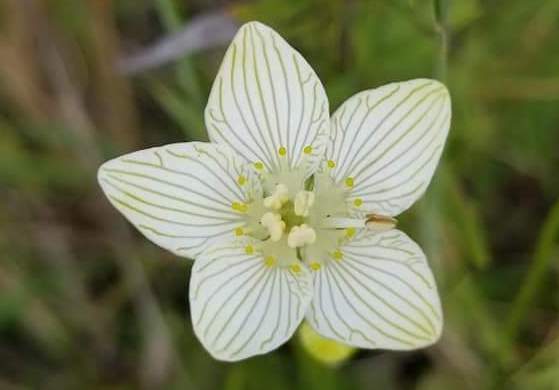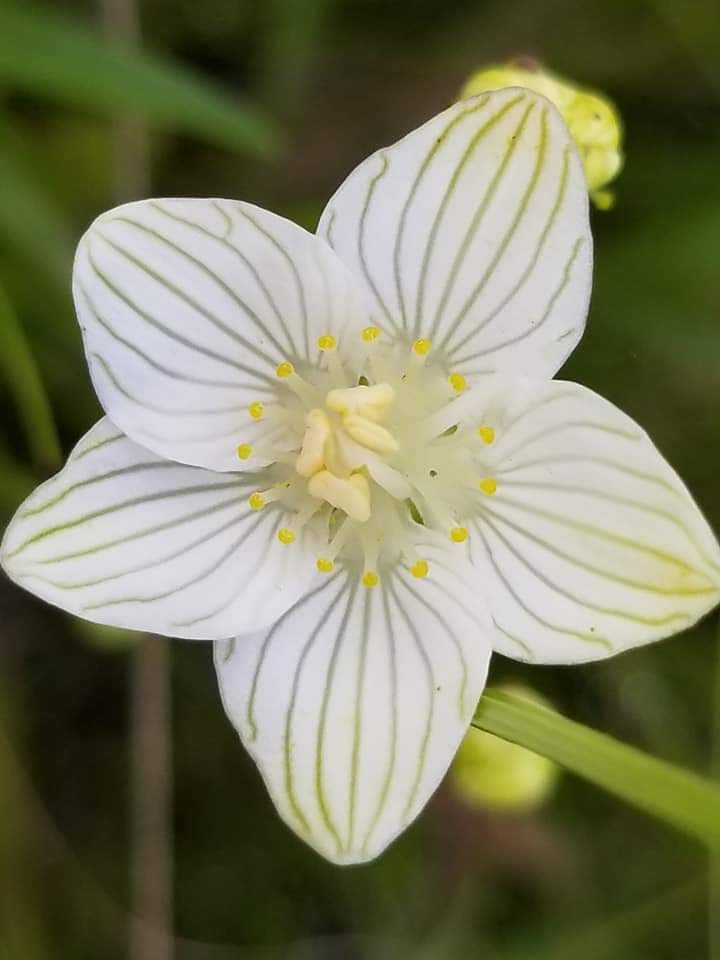Katie Byerly shares her images of a rare wetland plant she researched and photographed this summer. -promoted by desmoinesdem
“It’s pinstriped!” was a comment regarding my picture of Grass of Parnassus, posted in the Iowa Wildflower Report Facebook group. Its green-veined petals makes this plant easy to identify. . . if you can find it.
Marsh Grass of Parnassus (Parnassia glauca), also called Fen Grass of Parnassus or Bog-Stars, grows in wet calcareous habitats like fens, open ground water seepage areas, and wet prairies. The Minnesota Wildflowers and Illinois Wildflowers webpages both comment on the rarity of these habitats and subsequently this flower. Calcareous means to contain calcium carbonate occurring on chalk or limestone, and that’s exactly where I found my grass of Parnassus.
The Limestone Prairie Preserve is ten acres of old quarry donated to the Cerro Gordo County Conservation board in 1997. Plat books show this land being mined in the 1950s.
What I find most interesting is that when the county gained possession of the land 20 years ago, they never reseeded the land. Other than managing the tree growth with control burns, the native wildflowers have returned on their own. The Cerro Gordo County Conservation website advertises this public preserve as “a good place to search for unique prairie plants and fossils.” This prairie is in the far southeast corner of Cerro Gordo county not far from the Claybank Forest, Winnebago River and the Floyd County Fossil and Prairie Center.
The grass of Parnassus in these pictures was growing in what appeared to be the tracks of an old road around the edge of the quarry. I’m not sure if those tracks were wet from ground seepage or due to the constant rain we had this summer, but I found several other mesic loving flowers along this old road.
Grass of Parnassus is not actually a grass. It does have a long slender stem with a single flower at the tip. Without the flower and with its hidden basal leaves, the stem could be mistaken as grass, the Minnesota Wildflowers site notes. Parnassus refers to Mount Parnassus in Greece. The “ancient naturalist Dioscorides observed similar plants in meadows” of this mountain, according to the Lady Bird Johnson Wildflower Center at the University of Texas.
This plant blooms in late summer. I took these photos in August 2018. This wildflower prefers full sun and tolerates limited competition from other plants. I believe other wildflower hunters would agree that finding your flower just as the book describes it is fulfilling. Sunny location: check. Wetland: check. Limited competition: check.
Likewise, kindred spirits also understand why Sylvan Runkel and Dean Roosa described “finding a parnassia flower” as “a treasured experience” in their book Wildflowers and Other Plants of Iowa Wetlands. I hope my photos have inspired you to explore some of Iowa’s beautiful prairies and wetlands next season and share them with a friend.
Basal leaves of grass of Parnassus:
Single flower:
Group of flowers:
Closer views:












1 Comment
I am so grateful to the Cerro Gordo Conservation Board...
…for protecting this land and for not reseeding it. Good prairie remnants don’t need reseeding and should not be reseeded except in special circumstances. This park is gorgeous, and it’s such fun to see the various flowers and hunt for the fossils. And when I was there last, rare beautiful regal fritillary butterflies were flying around, also a treat. Thanks for the memories and lovely photos.
PrairieFan Wed 24 Oct 8:27 PM
Comments are closed.